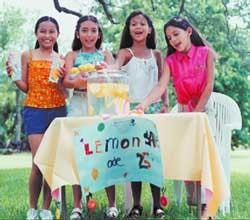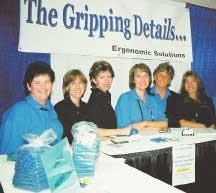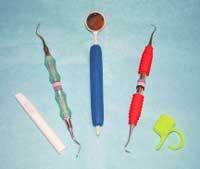Learning To Make Lemonake (Together)
by Anne Nugent Guignon, RDH, MPH
When Gail Bemis Stoops, RDH, attended the University of Alaska more than 20 years ago, no one told her that dental hygiene practice might be a risky profession.
New Hampshire hygienist Marann Ferranti, RDH, graduated in 1983 and never suspected that her beloved profession would alter her life so dramatically.
It never dawned on Shari Williams, RDH, of Coeur d'Alene, Idaho, that she might not be able to practice as long as she wanted.
Theresa Forgy, RDH, and Melanie Beck, RDH, practiced together in Kansas.
Neither ever thought they might become injured on the job.
After she graduated less than a decade ago from her hygiene program in Nevada, it didn't take Phyllis Prescott, RDH, long to experience hand pain from hygiene practice.
Each of these women's careers was plagued with a variety of workplace-related stresses and injuries. Several clinical careers were destroyed by injuries acquired from practicing dental hygiene. Others were affected for various periods of time. However, these stories end in victory as each woman tells how they individually met their adversaries head on and then joined forces. They are now leading the way for safety in dental hygiene practice with useful products, and they hope other hygienists can be spared from experiencing similar problems.
Land mines in the workplace
What do these women have in common, other than being female and practicing dental hygiene? They each loved their careers. Like most hygienists, they had a desire to operate at peak performance. Each one of them began to suffer various aches and pains and just kept on working. They thought the pain would vanish. Instead, it began to escalate as the injuries set in. Some injuries were not permanent but others required surgery.
While their individual stories are very different, there are some common threads that resurfaced. Each experienced a period that I will call the "lack of awareness." This was the pre-denial phase when they really did not think much about the pain. They had it and just accepted it. When they entered the denial phase they chalked up their fatigue, aches, and pains to practicing too many days, seeing too many perio patients or to their own pregnancies. After various periods of denial, each of them sought conventional medical treatment.
These hygienists collectively experienced the following injuries and disorders directly related to dental hygiene practice: arthritis; carpal tunnel syndrome; permanent inoperable nerve damage in the cervical spine; ligament laxity of the thumb; cubital tunnel syndrome; torn ligaments; tendonitis; ganglion cysts; severe hip myofascitis; and DeQuervain's tenosynovitis, a condition characterized by pain on the side of the wrist just above the thumb.
They have spent countless hours icing down their joints, going to physical therapy, researching their conditions, and trying to learn to practice differently. Thousands of dollars have been spent pursuing an accurate diagnosis. Their bodies have been subjected to a banner of neurological tests, magnetic resonance imaging (MRIs) and diagnostic radiographs. They have had cortisone injections, been fitted with various types of splints, and have taken massive quantities of anti-inflammatory medications.
A total of eight hand surgeries have been performed on three of these women. One eventually will need a total joint replacement in both thumbs. Another is struggling with daily exercises and therapy to try and straighten out her little finger, which has been left with a claw deformity. And another will never be sure if she first had a problem in her spine that was aggravated by seven years of dental hygiene practice, or the other way around.
Fortunately, each of the surgeries was covered by worker's compensation — but not without a lot of effort on the part of the injured hygienist. They spent hours trying to help examiners understand that their injuries were job related. Files were "lost" in the paperwork shuffle. Delays were common. At times, the questions were humiliating. Theresa Forgy said the process made her feel like a criminal. Each woman was amazed at the type of questions the bureaucrats asked. One examiner even asked Shari Williams why she could not continue practicing dental hygiene since only one hand was affected.
Each woman experienced hundreds of sleepless nights trying to make sense of what went wrong. Once they were over the initial shock of their predicament they began to wonder, "How did this happen to me?"
How could these injuries have been prevented? Conventional hand instrumentation was the core issue in the development of their injuries. Each made a vow to help hygienists around the world stay healthy. Individually, they started on the quest to build a better mousetrap, but, as with most good stories, their paths were destined to cross.
Climbing out of the box
Both Melanie Beck and Theresa Forgy worked together in a periodontal practice. They used lightweight plastic mirrors for soft tissue retraction. They both realized that they used an excessive pinch/grip on the mirror handle. Theresa was the first to get injured. She began to experiment with rubber tubing that would slide over the mirror handle, enlarging the grip as well as providing a soft surface. The original smelly rubber tubing was primitive, but Theresa and Melanie kept experimenting with their idea.
Both women were raised in entrepreneurial environments and realized the importance of their partnership. Even though Theresa's thumb injuries will never allow her to practice again, she loves dental hygiene and did not want to live without it. Melanie also was forced to retire from clinical dental hygiene because of her injuries. Last fall, after more than a year of trying out different materials and talking with a number of manufacturers and distributors, they began to market the disposable Acushy mirror grip. An autoclavable Acushy is in developmental stages. Theresa loves marketing and product development. So she runs the day-to-day business operations. Melanie just began graduate school.
Shari Williams is the queen of hand surgery. Every time she had surgery, she couldn't wait to get back to dental hygiene practice and teach clinical dental hygiene. She started noticing that larger diameter instruments created less hand discomfort, so she contacted a design engineer. Shari wanted an instrument grip that would enlarge an instrument shaft diameter to half an inch and improve the grip. The first Chubbies® were developed by the engineer in a matter of days in his home kitchen using industrial tubing, super glue and boiling water.
Shari's colleagues, as well as her students at Eastern Washington University in Spokane, field-tested the prototypes, looking for ways to perfect the device. By the spring of 1999, Chubbies were introduced to the hygiene market. The autoclavable Chubbies are ribbed and available in a variety of colors, which aids in instrument identification. Shari also feels her product helps hygienists scale in two ways: greater instrument control in addition to improved lateral control. Her most recent invention, SurgiChubs®, is more flexible and can be placed on larger diameter dental instruments. Shari recently quit teaching and private practice, not because of hand pain but because of a thriving Chubbies business.
During her first surgical recovery, Marann Ferranti was compelled to research hygienists' clinical injuries. She wanted to learn what was really required of our hands in clinical practice. She was looking for ways to take the forces off of the thumb joint, which accounts for more than 70 percent of hand function. Marann was also interested in reducing the lateral pressure that is required to remove calculus and felt that increasing instrument diameter was only part of the answer.
In 1998, she started to work with wax-ups of her ideas. Once she had developed some prototypes, she asked an ergonomist, who is also a hand specialist, to evaluate her design. Marann wanted an instrument grip that would keep the fingers positioned in a modified pen grasp and improve leverage without increasing thumb joint stress. She designed ErgoGrasp® with special crests that increase the instrument diameter while assuring that a clinician's fingers would not slide down the instrument shaft.
After an engineer drew up her ideas, Marann found a company near her New Hampshire home that was experienced in fabricating silicone devices that could be autoclaved, would have just the right amount of softness, and could be used to enlarge the shafts of either #2 or #4 scaler. She had the ErgoGrasp ready for the general dental market by the end of 2001. While Marann will never be able to hold an instrument again, she hopes her series of daily exercises and hand therapies will rid her of the claw deformity remaining in her right hand.
Gail Bemis Stoops also experienced a series of injuries due to instrumentation but the trauma affected her hip and neck rather than her hands. Gail uses a high volume suction tip when she uses an ultrasonic scaler. However, she noticed that a traditional tip was too long to be used comfortably. She found herself leaning forward, balancing her weight on one hip, with her opposite heel raised and toes on end so she could position her arm high enough to align the suction with the ultrasonic tip.
Once Gail concluded that solo practitioners needed shorter suction tips, she also reasoned that slits or holes in the tip, opposite the working side, would capture more contaminated aerosol and reduce the chance of sucking up a patient's soft tissue. She spent months at her clinical practice in Arizona developing a tip that would have just the right aperture and the exact number of slits cut at just the right length. Initially, slits were cut on the top of shortened suction tips and then field-tested for weeks in private practice. Finally she found the right design and named the product the L.A.S.T. (low aerosol suction tip). Gail's final challenge was to find an autoclavable polymer so the tip could be reused and not contribute to the world's landfills. The L.A.S.T. became available in early 2001.
Phyllis Prescott started noticing hand and general body fatigue only a few years after her graduation in 1994. She also found that relying on her ultrasonic scaler more and more rather than her hand instruments seemed to help her symptoms. Phyllis also noticed that the metal ring holders for the paste were often missing from the tray setups and that many hygienists held on to the prophy cup with their fingers, resulting in sustained periods of tight pinch grip. Even if she could find a holder, the paste cups frequently did not fit securely and ended up popping out onto the floor.
Phyllis decided to design an autoclavable paste holder that could be adjusted to any finger size and be held securely in one place. A designer drew up her ideas and she had a mold fabricated in Arizona. For the first couple of years, she spent all of her "down time" making thousands of Unique prophy cup holders at a machine shop in Las Vegas. Phyllis recently relocated to Idaho, where she practices dental hygiene full time in addition to marketing the Unique holder.
The lemonade stand
Fate has a funny way of bringing people together. Last spring my phone rang. Theresa's business partner Melanie had been reading my RDH column for months and felt that I would know how to get an ergonomic seal of approval for a unique device that they had developed. Theresa was in charge of contacting me. Even though she was disappointed that I wasn't aware of any special certification she was pleased to hear that I would be happy to help them in any way that I could. After signing a non-disclosure agreement, they shared their Acushy mirror grip ideas and prototypes with me and kept me up to speed as the product developed.
Several months later, I attended the ADHA meeting in Nashville. Shari Williams had a booth in the exhibit hall. Her designs were so intriguing that I ordered a package of SurgiChubs as well as Chubbies. As soon as they arrived, I began modifying my own instrument handles and even suggested that she contact the manufacturer of the Diamond Probe because I had found their probe handle too slim and tooth smooth. SurgiChubs are now included with every Diamond Probe so that clinicians will be able to easily modify the existing handpiece to one with a larger diameter.
Theresa, Melanie, and Shari had intrigued me. They were each working hard to solve our profession's problems and they were making a dent. The Acushy and Chubbies have unique capacities to help clinicians ward off the ravages of workplace injuries. Their products became the inspiration for my January 2002 RDH column, The Gripping Details. I was inspired to use the mighty pen to help them get their products off the ground but also wanted to do more. As soon as the issue was in the mail, I heard about Marann's device, the ErgoGrasp, and wrote about her product in another column.
One of the best ways to contact hygienists is through a booth at a professional meeting where potential buyers can see and touch products. Exhibit space and travel to meetings is expensive. Theresa and Melanie did not know Shari and Marann so I e-mailed them collectively and suggested that they consider sharing exhibit space and expenses at meetings. Since workplace safely in dental hygiene practice was becoming an important issue to many clinicians, they could band together as The Gripping Details and gain increased exposure for their products.
These women are entrepreneurs. They recognized the upside potential of working together. Before they could exhibit together as The Gripping Details, these hygienists verbally committed to forming an LLP, a limited liability partnership. This would allow them to operate as The Gripping Details but still maintain independent businesses. The group is focused on education and marketing devices that prevent workplace-related injuries for dental practitioners.
They were off and running but kept me in the loop via e-mail with their plans to exhibit jointly at the ADHA Meeting in Beverly Hills. As the meeting grew closer, Shari invited Gail, her friend of many years, and fellow Idahoan Phyllis, to join The Gripping Details booth. Shari, the experienced exhibitor, secured booth space and all of the furnishings. She even ordered matching shirts embroidered with each hygienist's name next to The Gripping Details title.
To reduce expenses, the group decided to share hotel rooms as well, even though most had never met. They were now in for a test of a lifetime. Could they work together? Would they like each other? As soon as they met, they started bonding. They were all in this adventure for the same reasons. Even though their booth at the ADHA exhibit hall was in a less-than-ideal location, they were busy all weekend. It was obvious that word was getting around that The Gripping Details had something special to offer the practicing hygienist.
During the weekend, they also found that they had additional support and talents to bring to the table that they could all draw from. Shari has the most exhibiting experience at this point. Theresa loves to market, and her husband is a CPA and financial planner. Gail presents continuing education seminars all over the country and Marann's husband is an attorney. While they are individually and collectively testing the waters, these women are making plans for their futures. Over time it is likely that they will discover many other skills and resources at their disposal that can make The Gripping Details an even more exciting and rewarding joint enterprise.
Each of these women could have succumbed to self-pity and isolation as a way to deal with the lemons that they were handed, but instead each made their own pitcher of lemonade.
Anne Nugent Guignon, RDH, MPH, priactices clinical dental hygiene in Houston, Texas. She writes, speaks, and presents continuing-education courses on ergonomics and advanced ultrasonic instrumentation through her company, ErgoSonics (www.ergosonics.com). She can be reached by phone at (713)974-4540 or by e-mail at [email protected].


